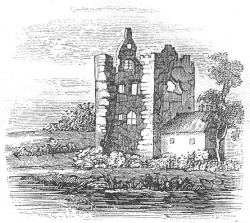Rheban Castle, County Kildare
From The Illustrated Dublin Journal, Volume 1, Number 20, January 18, 1862
RHEBAN was, in the second century, one of the inland towns of Ireland.
The castle stands on the western bank of the Al Berba, Birgus, or
Barragh, (the boundary river,) now the river Barrow. It was built, or
greatly enlarged, in the early part of the thirteenth century, by
Richard de St. Michael, when this and Dunamase, an adjoining district,
were erected into a barony. Rheban was found of consequence to the
first English settlers, who repaired and strengthened the castle, as
also the opposite one of Kilberry, both intended to protect a ford on
the river. The name of this castle was anciently Raiba, or Righ-ban,
that is, the habitation of the king; and though now in ruins, some idea
can be formed of its former grandeur. Its massive walls--its mullioned
windows, with its imposing situation, show it to be a place designed to
awe the surrounding country, and forcibly call to mind the days when
the chivalrous De St. Michael held his court here in feudal splendour,
and lorded it over the petty chieftains of the borders of the Pale.
It was built, or
greatly enlarged, in the early part of the thirteenth century, by
Richard de St. Michael, when this and Dunamase, an adjoining district,
were erected into a barony. Rheban was found of consequence to the
first English settlers, who repaired and strengthened the castle, as
also the opposite one of Kilberry, both intended to protect a ford on
the river. The name of this castle was anciently Raiba, or Righ-ban,
that is, the habitation of the king; and though now in ruins, some idea
can be formed of its former grandeur. Its massive walls--its mullioned
windows, with its imposing situation, show it to be a place designed to
awe the surrounding country, and forcibly call to mind the days when
the chivalrous De St. Michael held his court here in feudal splendour,
and lorded it over the petty chieftains of the borders of the Pale.
The Richard de St. Michael in question founded a monastery in Athy, on the west (his own) side of the river for crouched friars, under the invocation of St. John. A burial ground and some remains still exist. There was another religious edifice erected by the families of Boesel and Hogan, at the east entrance of the town, and dedicated to St. Michael, which is erroneously stated to have been the one founded by De St. Michael, Lord of Rheban. A coincidence between the names of the supposed founder and the monastery, called as it is St. Michael's, may have led to the mistake.
In 1325, in the absence of the English settlers, Rheban, Dunamase, and all their dependencies, were taken by O'Moore.
In 1424, Thomas Fitzgerald, Lord of Offaly, and afterwards seventh Earl of Kildare, marrying Dorothea, daughter of Anthony O'Moore, received in dower the manors of Rheban and Woodstock.
In 1642, the Marquis of Ormond took Rheban from the rebels, after an obstinate resistance.
In 1648, it was taken by Owen Roe O'Neill, who was afterwards defeated by Lord Inchiquin, and compelled to surrender Rheban and Athy.
Near the castle was a very high conical mount, thought to have been a sepulchral mound, raised over some king or chieftain, and though artificial in a great degree, there was, nevertheless, advantage taken of a natural height, as may be seen by the undisturbed beds of gravel that have been taken from it for road purposes.
Rheban is situated in the parish of Churchtown, and union of Athy, about two-and-a-half miles north-west of the latter.
